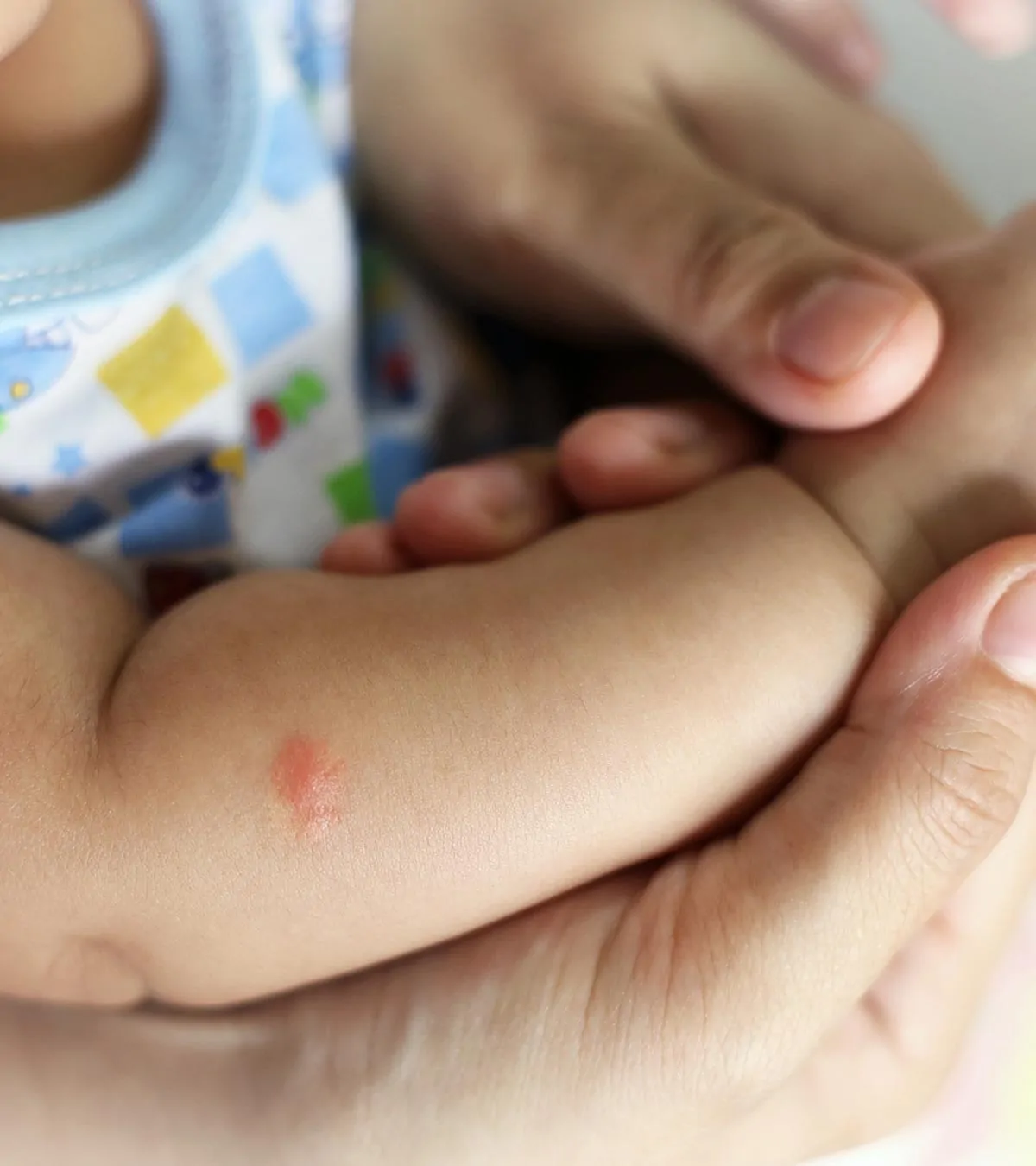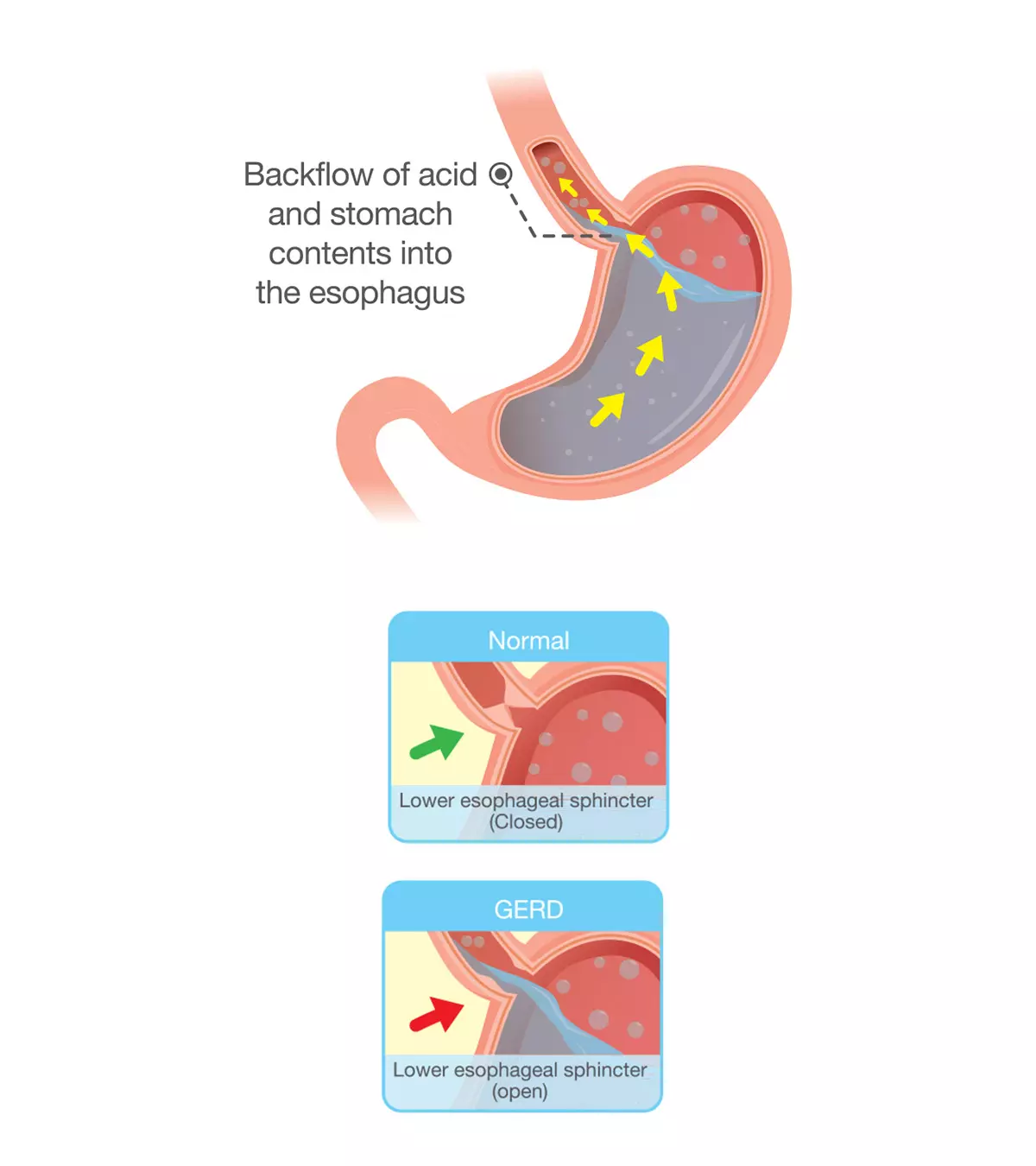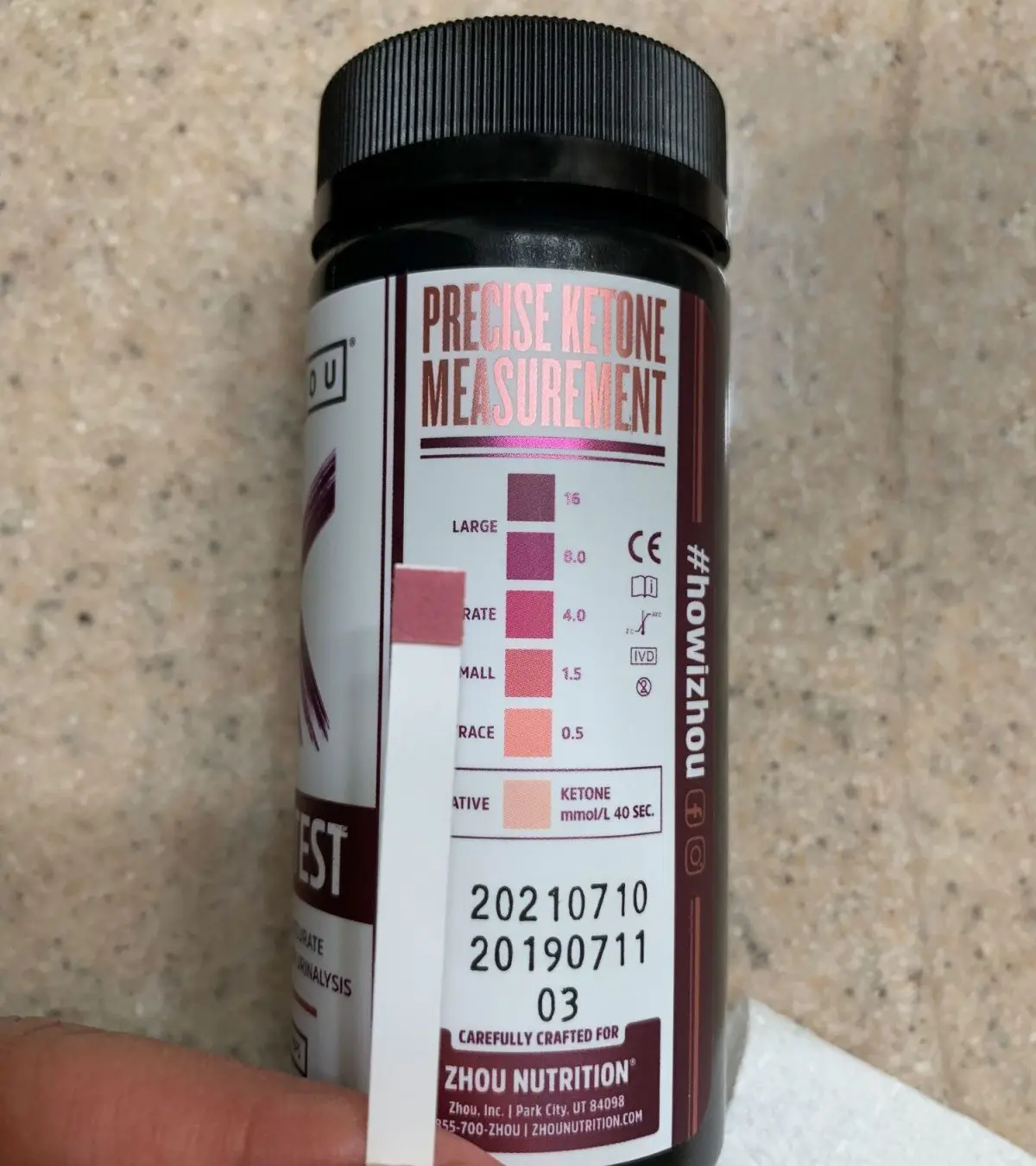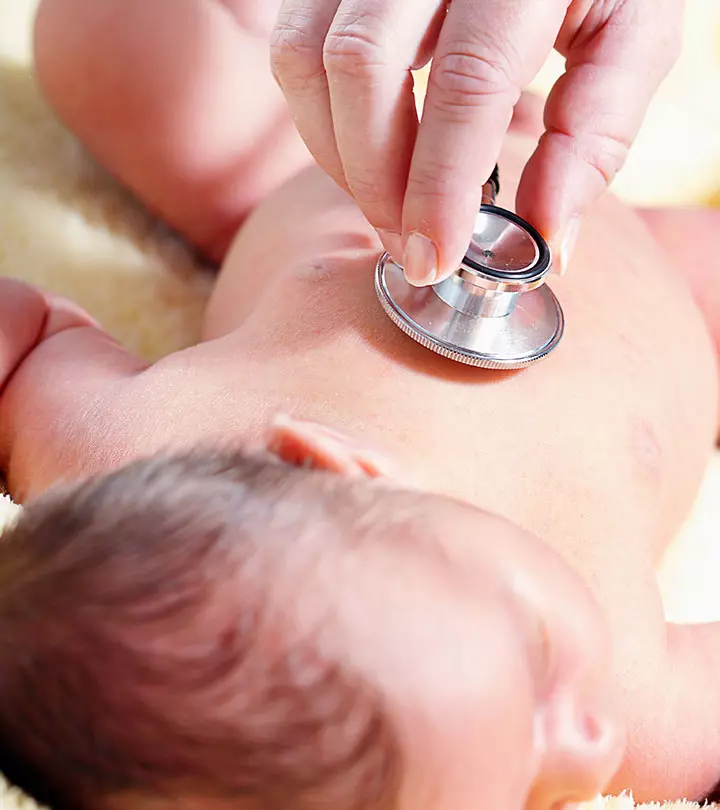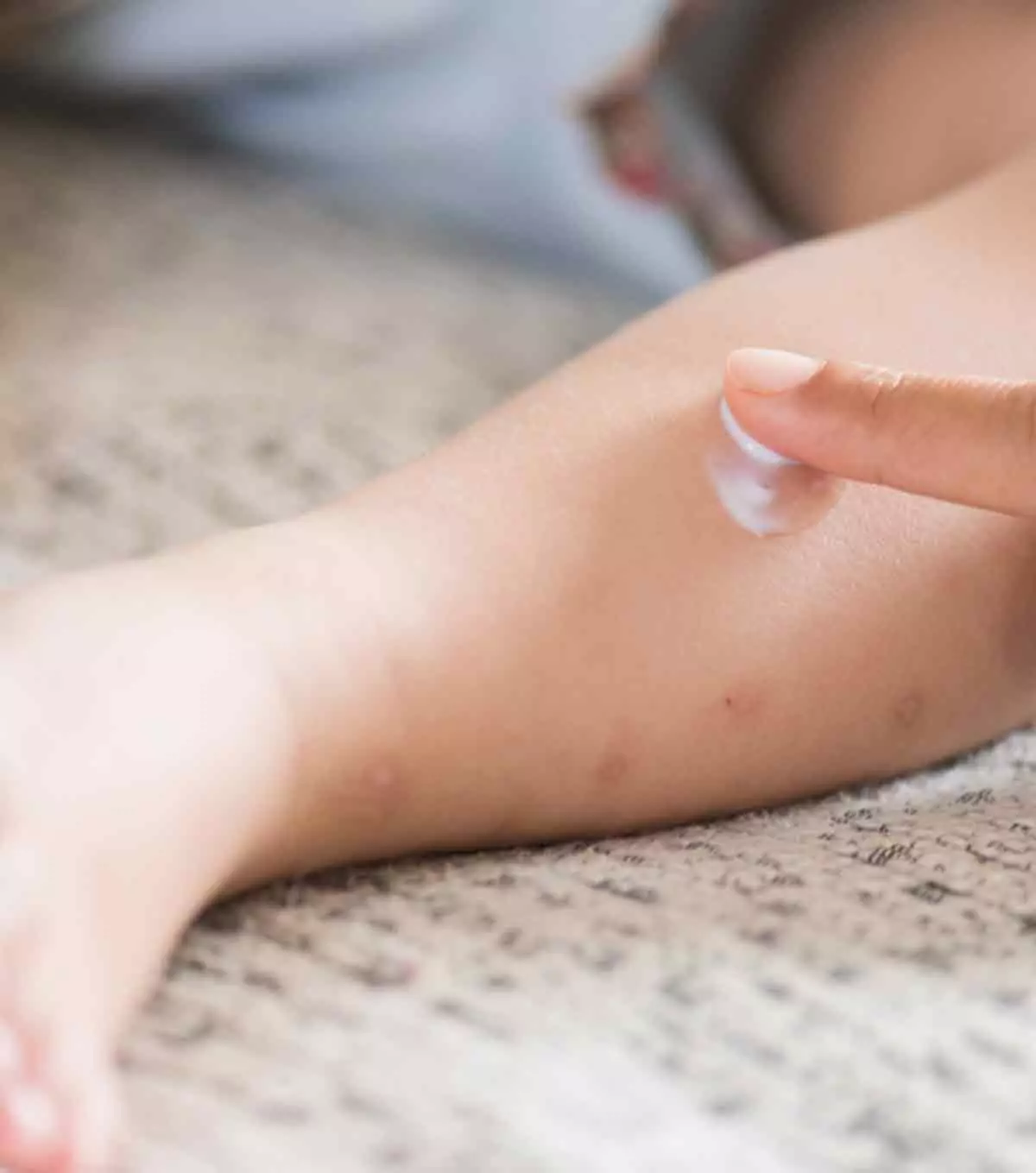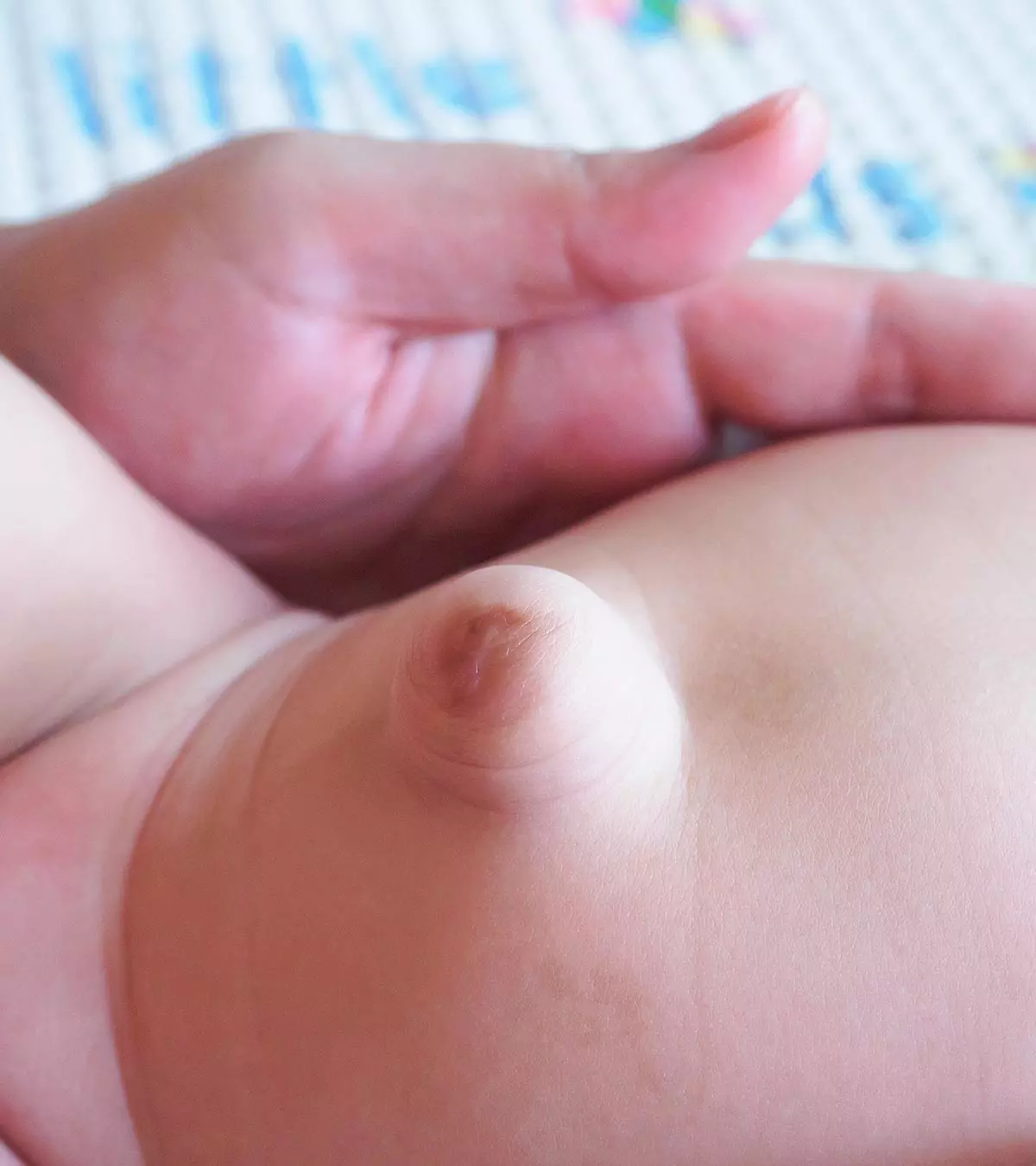
Image: ShutterStock
The term umbilical hernia is used to describe a condition where a part of the intestine pushes through a weak spot in the muscles that hold it in. An umbilical hernia in babies may appear as a bulge near the naval area (24). Umbilical hernias may resolve without treatment. However, it is advisable to discuss with your pediatrician to be fully certain. Read this post to learn what may cause hernia in babies, its diagnosis, and treatment options.

Key Pointers
- Umbilical hernia is when a loop-like part of the intestine protrudes from the abdominal wall near the waist or navel area.
- Premature babies, babies with congenital hypothyroidism, and genetic conditions are more prone to developing umbilical hernias.
- The main symptom of hernia is bulging around the navel, hip, or scrotum, which can become inflamed and red.
- Infants with developmental problems, family history, hip dysplasia, and premature birth have a higher risk of developing hernias.
- Hernias usually heal on their own, but complex cases require minor surgery; untreated hernias can cause health complications.
What Is Hernia?
When an organ breaks a delicate tissue or enters an opening in the muscles, where it does not belong, it is called a hernia.
An abdominal hernia is the extrusion of the loop-like section of the small intestine from the abdominal wall. In other words, a section of the small or large intestine breaches the abdominal wall and slides out to cause a visible external bulge.
When the intestine slips out around the waist area, near the navel, it is called an umbilical hernia. When the breach is around the lower waistline or the groin, it is called an inguinal hernia (1).
How Common Is Hernia In Babies?
According to the British Hernia Center, an inguinaliRelated to the groin. hernia occurs in 3-5% of full-term newborns and 30% of premature babies. Right inguinal hernia, wherein the bulge is on the right side of the body, is far more common than a left inguinal hernia. Umbilical hernias can occur in one out of five infants, but the condition is far more common in premature infants and those with Down’s syndromeiA chromosomal disorder caused by the presence of an extra copy of chromosome 21, resulting in intellectual impairment and short stature. (2). It is also seen more in children with rarer diseases like Ehlers Danlos diseaseiA group of inherited disorders that affects the connective tissue that supports the skin, bones, organs, tissues, and blood vessels. , Beckwith Wiedeman syndromeiA genetic condition identified as an overgrowth syndrome that may make infants appear larger than normal. , children with congenital hypothyroidism (underfunctioning thyroid gland), and other chromosomal defects like Trisomy 18.
What Causes Hernia In Babies?
The causes of hernia are determined by where it occurs in the body.
1. Inguinal hernia
A hernia around the waistline and the groin region is referred to as an inguinal hernia. It is the breach of the intestine from the lower abdominal wall into the inguinal canals, which are a pair of tube-like segments within the lower abdomen wall.
An inguinal hernia occurs about 90% of the time among male infants. In a male fetus, the testicles are developed by the seventh month of gestation. After that, each testicle gradually descends to the scrotum through the inguinal canal, making it narrow and allowing only the blood vessels and spermatic cord to pass through (3).
When the narrowing does not happen correctly or when the testicles do not descend properly, the inguinal canal becomes a site of a hernia. The intestine easily slips into the inguinal canal, causing a hernia. Since the intestines slip into the scrotum of the male infants, it is also called a testicular hernia.
Female infants have an inguinal canal from where a ligament of the uterus passes through. If the inguinal canal is defectively wide, the intestine can slip into it and cause a hernia, although it is less common (4).
2. Umbilical hernia

It is a prevalent condition in newborns, affecting around 15%-23% of newborns, i.e., around 800,000 newborns per year in the United States. However, as babies progress to one year of age, the incidence rate significantly decreases to 2-10% (24). In this case, the bowel slips out from the abdominal cavity near the navel/belly button region. The fetus inside the womb receives nourishment from the placentaiA temporary organ that develops during pregnancy and provides the fetus with oxygen and nutrients. through the umbilical cord that attaches to the abdomen of the baby. The development of an outie belly button is often the first sign of umbilical hernia, though there may be other reasons for it, as well.
The abdominal muscles leave a gap to facilitate the passage of the cord. However, these muscles shut close before the baby is born. If the muscle does not close, a section of the intestine can slip out of the gap in the abdominal muscles and cause a hernia (5).
Hernias can happen congenitally or may appear a few days or months after birth. Some factors increase the risk of a baby developing hernia.
 Quick fact
Quick factRisk Factors For Baby’s Hernia
The likelihood of hernia at birth or after birth is significantly greater in the following scenarios or conditions (6) (24):
- Premature birth
- Low birth weight
- Metabolic disorders, such as hypothyroidism and mucopolysaccharidosesiA group of metabolic disorders caused by the absence or malfunctioning of lysosomal enzymes that breaks down complex sugars called glycosaminoglycans (GAGs)
- Genetic conditions, such as autosomal trisomiesiA genetic condition occurring due to the presence of an extra autosomal (non-sex) chromosome, leading to developmental abnormalities and intellectual disability
- Developmental problems in the genitals or the urinary system
- Diagnosed with cystic fibrosisiA genetic disease characterized by the build-up of mucus and affects the lungs, digestive system, and other organs. or Down’s syndrome
- Undescended testes in male infants
- A hernia in the parent, sibling, or an immediate relative
- Born with hip dysplasia, a condition where the thigh bone does not correctly align with the hip joint on the pelvis (hip bone)
- If a baby develops another condition that leads to chronic rise in intra-abdominal pressure, like fluid build-up (ascites)
What Are The Symptoms Of Hernia In Infants?
The symptoms of an inguinal and umbilical hernia are similar, with the primary difference being the site of the bulge. Here are the symptoms of inguinal and umbilical hernia in babies (7) (8):
- A bulge around the navel, hips, or scrotum: You may notice a bulge or a finger-like protrusion around the navel in the case of an umbilical hernia. The navel (belly button) itself will appear swollen. In the case of an inguinal hernia, you may notice a bulge around the waistline and near the groin. For male infants, inguinal hernia causes a swollen scrotum, which means you may see swelling in one or both testicles. In the case of an umbilical hernia, bulging or swelling in the baby’s belly button area may become more apparent upon crying, straining, or coughing (24).
- A chronic bulge that reappears: Sometimes, the hernia could be prominent only when the baby is crawling, crying, or standing. Other times it could be invisible as the intestine slips back inside but reappears where there is stress on the abdominal muscles. This is an indication of a reducible hernia (3).
- Redness around the bulge: The skin around the bulge appears red and slightly inflamed.
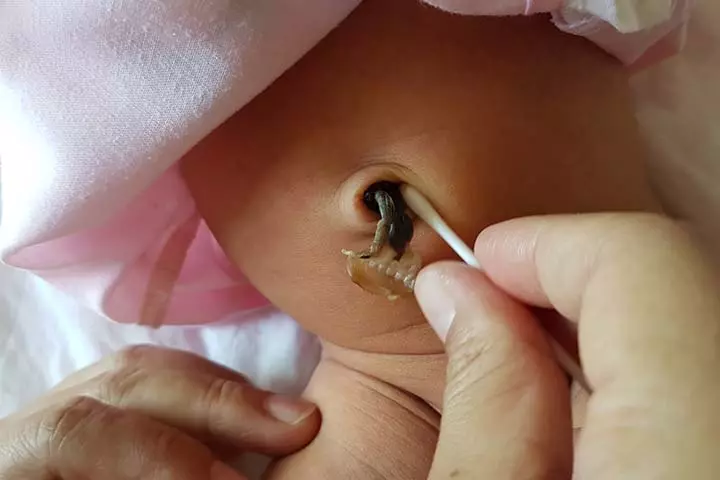
- Localized pain: Touching the bulge or the area around makes the baby squeal or cry, indicating pain.
- Stomach pain, vomiting, and nausea: Along with the bulge, the baby may also have abdominal discomfort, vomiting, and nausea due to the compression of the intestinal loop.
Jennifer, a mother of three children, shares her experience with her son’s hernia diagnosis. She says, “From what we could physically see with our eyes and feel, our son had an umbilical hernia above his navel and a large rare indirect inguinal hernia on his left side. When our son would cry, the hernias would bulge. I believe he was in a lot of pain since we discovered the hernias, especially with the large one that was probably pressing on his stomach. For instance, he would only eat 2 oz. of breast milk at a time and would hardly breastfeed at all. Within minutes after eating, he would scream in pain (i).”
If you suspect the baby has a hernia, then take them to a doctor for a check-up.
How Is Hernia In Infants Diagnosed?
A doctor will use the following methods to diagnose hernia in babies (9):
- Visual and physical examination: The trained eye of the doctor can spot a hernia by the shape of the bulge. The doctor will physically examine the lump by trying to press back the intestine to its place. It helps the doctor determine the severity of a hernia.
- X-rays: An X-ray can point to the exact spot where the bowel slips out and how far it extends.
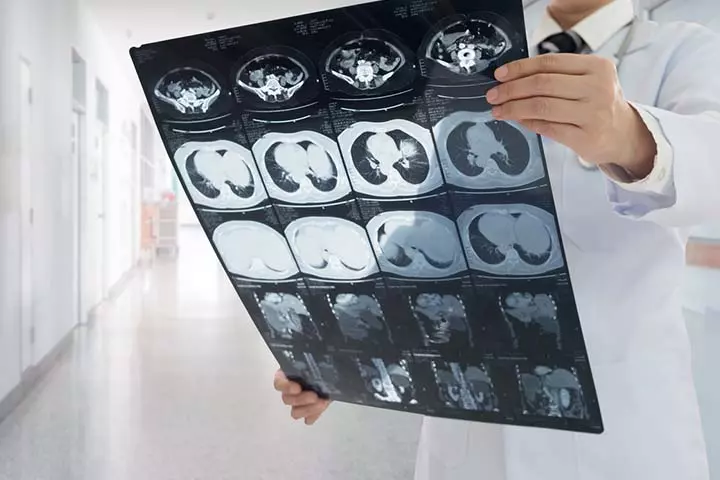
- Ultrasound: An ultrasound scan diagnoses strangulation, which is a hernia complication that causes intestines to twist into a knot.
The doctor would suggest a treatment after assessing the severity of the hernia.
Can a hernia heal naturally?
Yes, some cases of umbilical hernia can heal on their own, but inguinal hernia always requires surgical intervention. The size of the opening in the abdominal muscle can help us determine whether the hernia heals naturally.
Overall, about 90% of all umbilical hernias heal by the age of three, or at most by the age of 11 years. Some cases of umbilical hernia only heal once the child is older than ten years. If a hernia continues to exist after puberty, then surgical intervention is necessary to treat the condition (10). Additionally, if the umbilical hernia is larger than 1.5cm in diameter and does not resolve by five years of age, surgical intervention will be required (25).
Also, babies with umbilical hernia may require surgery if they show (24):
- Fluid build-up (ascites)
- Bowel injury
- Rupturing of hernia
- Abnormal protrusion of hernia
- Incarcerated herniaiA condition when the abdominal tissue or bowel becomes trapped within the hernia sac, causing complications like bowel obstruction
- Strangulated herniaiA medical emergency that occurs when the blood flow to herniated tissue is cut off
- Skin problems over the hernia defect
Babies with umbilical hernia who also have metabolic syndrome or genetic conditions may also need surgical intervention.
How Is Hernia In Infants Treated?
Surgery is the only way to treat an inguinal and umbilical hernia. Even if the hernia is reducible, it could keep coming back but will never disappear on its own (11). The doctor will discuss and prescribe the appropriate number of breastfeeding or formula feeding sessions that you need to have a day before the operation.
Here is something you should know about the surgical procedure (12) (13):
Inguinal hernia treatment
- The surgery is performed under general anesthesia. A tiny cut is made in the lower abdomen around the hernia lump. In some countries an inguinal local or regional block can be used instead of a general anesthesia.
- The intestine is manually pushed back to its normal position, and the hole in the abdominal wall stitched closed with dissolvable stitches. The outer incision is stitched, and the operation is complete.
- The entire procedure takes 30 to 45 minutes.
- In case of an abnormality in the inguinal canal, the doctor may perform additional surgical procedures to correct the size of the canal.
- Premature babies with a hernia may have to wait a few months for the baby to reach a healthier state for the operation.
 Did you know?
Did you know?Umbilical hernia treatment
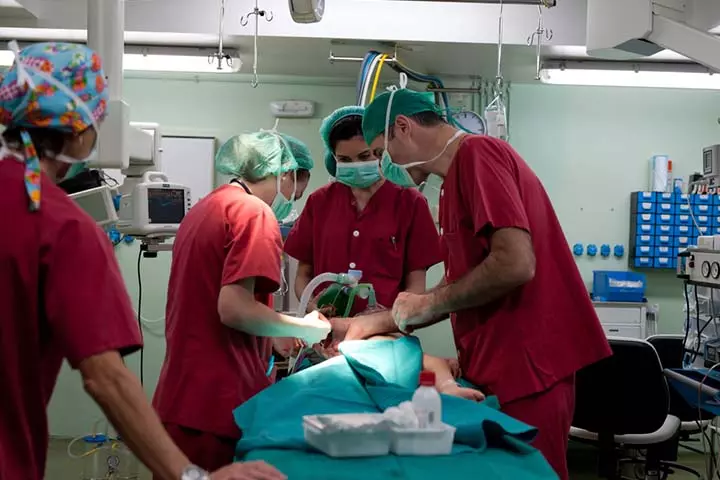
- The surgical procedure is quite similar to that of an inguinal hernia.
- The baby is administered general anesthesia – it cannot be done just with a regional block.. An incision is made around the navel, and the intestine is pushed back to its appropriate place.
- The abdominal wall and muscles are stitched back to prevent the occurrence of another hernia.
- The incision is stitched.
In most cases, you can take the baby home a few hours after the operation. The surgery is seldom risky, and the benefits of the surgical procedure outweigh leaving the hernia as it is. However, note that post-surgical care plays an important part in aiding the infant’s recovery.
How To Care For Baby After Hernia Operation?
Here is how you need to take care of the baby after a hernia operation (9).
- Keep the incision dry and clean: Do not let the stitched incision come in contact with water. Bathe the baby only when the doctor gives you permission for it, which is usually 24 hours after the surgery. It is best to give sponge baths for at least two days after the surgery, or for as long as the doctor recommends it.
- Do not touch the incision: You may accidentally transmit germs into the incision by touching it and cause an infection.
- Limit physical activity: Limit the baby’s movement for at least a day after surgery. It can help the incision and the site of hernia heal faster. Consult your doctor about when your baby can return to the usual physical activities.
- Visit the doctor for follow-ups without fail: Make sure you attend all the follow-up sessions with the doctor, even if the incision seems dry and healed.
Probable Side Effects And Complications Of Hernia Operation
There are rarely any complications of a hernia operation, but knowing how to spot a post-operation problem is vital. Here are some possible side effects of hernia operation in babies that you should be aware of (14) (15):
- Colic and fussiness because of anesthesia. These effects taper away a few days after the surgery.
- Inflammation and redness around the incision. It indicates infection, and in some cases, you may also notice pus.
- Swelling around the incision and the area where the hernia was present.
- Blood, pus, or a clear liquid is oozing from the incision.
- Nausea, vomiting, diarrhea, or constipation after surgery.
- Fever with a temperature of over 100.4°F (38°C).
If you notice any of the above symptoms, rush your baby to the doctor right away. While there may be complications, surgery still protects your baby from several life-threatening complications of hernia.
What Are The Complications Of Untreated Infant Hernia?
A hernia can cause long-lasting complications. Here is what could happen if you leave a baby’s hernia untreated (16):
- Chronic constipation: The baby could suffer from constant constipation that cannot be cured. The poor passage of food through the bowel affects the functions of the digestive system.
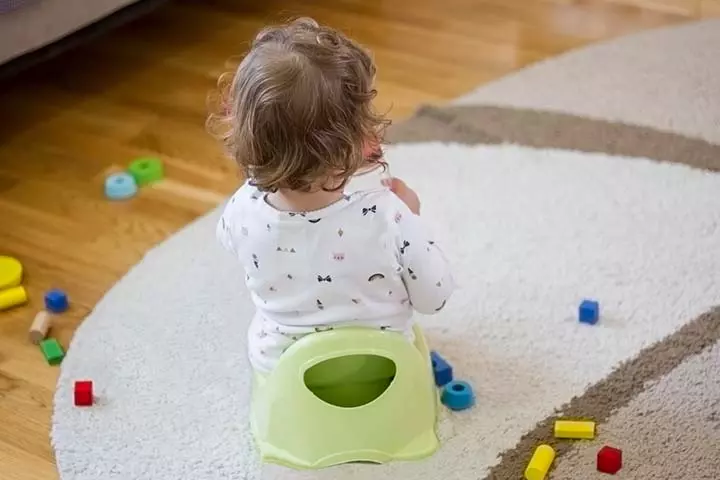
- Incarceration: Incarcerated hernia could happen when the intestine is significantly out of its place. It complicates the surgery and the subsequent healing process. It also means that the baby may have other complications such as poor appetite and constant pain in the abdomen/groin.
- Strangulation: When a section of the intestine twists and turns into a knot, then the hernia is called a strangulated hernia. In such a case, the bowel is completely blocked, and the passage of food becomes impossible. Blood vessels are compressed, and the herniated bowel does not receive blood supply.
The tissue slowly starts dying, causing a host of other problems including high fever, intense pain, considerable swelling, and redness around the hernia. Strangulation is a life-threatening complication of hernia and requires emergency surgery.
- Infection: Since the intestine is out of its usual place, it could get exposed to pathogens and other germs that cause infections. Infections can also happen when the food stays in the bowel for longer and attracts bacteria.
- Damage to reproductive organs: An inguinal hernia in males could put pressure on the blood vessels that lead to the testicles. As a result, the testicles receive less blood, which can cause tissue damage. Strangulation in inguinal hernia can cause permanent damage to a testicle, and it may have to be surgically removed.
Your baby is protected from these complications when you get the surgery done on time.
Can You Prevent Hernia In Babies?
There is no way to prevent a hernia (17). There is also nothing you can do before or after the baby’s birth to mitigate the chance of a hernia (18). A pediatrician can diagnose a hernia during the routine check-ups. Parents must be extra observant of any signs indicating hernia for timely treatment.
Frequently Asked Questions
1. What are the types of hernias in babies?
Hernias come in different types and require varying levels of medical attention. The two most common hernias in children are inguinal (located in the groin) and umbilical (located around the belly button). Another type, called epigastric hernia, occurs when a section of the intestine bulges through the muscles between the chest and belly button (20)
2. Is hernia in babies hereditary?
Those who have a family history of hernias are more likely to experience them due to genetics being involved (21).
3. Are hernia in babies dangerous?
Although hernias are typically not problematic, they can potentially result in severe health issues. Hence, parents should consult their child’s pediatrician if they detect any symptoms of a hernia (21).
4. How long does it take to recover from hernia in babies?
The recovery time of a child following surgery varies and depends on individual circumstances. Most children can resume normal, non-strenuous activities within one to two weeks. However, it is essential to note that your surgeon may provide different or more specific instructions. During the initial period of recovery, your child will be required to refrain from bathing for two to three days (22).
5. What is the best diet for babies with hernias?
The ideal food for babies with hernias is to ensure they drink lots of water and eat fruits, veggies, and fiber-rich foods. Such a diet can prevent constipation (23).
Hernia in babies can be either umbilical or inguinal. Inguinal hernia is more common in premature babies than full-term babies and needs medical intervention. Umbilical hernia in babies is also common, and most cases resolve without any medical intervention. If you notice any abnormal protrusion accompanied by pain, redness, increased crankiness, or crying in your baby, you should have them examined by a health care professional. If left untreated, it could result in chronic constipation, strangulation, etc. Although hernia cannot be prevented, early intervention can improve the prognosis.
Infographic: Does My Baby Need Surgery For Umbilical Hernia?
Umbilical hernia in some babies may resolve within a few years without treatment and complications. However, some babies may require delayed or emergency surgical repair to avoid complications. Go through the infographic to know the indications for umbilical hernia repair in babies. Illustration: Momjunction Design Team
In this video, familiarize yourself with hernias in children and gain insights into prevalent symptoms and treatments. Equip yourself with knowledge on identifying and managing hernias in young ones.
Personal Experience: Source
MomJunction articles include first-hand experiences to provide you with better insights through real-life narratives. Here are the sources of personal accounts referenced in this article.
i. Our brave baby boy’s surgery;https://jenblogpage.blogspot.com/2013/09/our-brave-baby-boys-surgery.html?m=1
References
1. Inguinal and Umbilical Hernias in Children; Stanford Children’s Health
2. Pediatric Hernia; The British Hernia Center
3. Inguinal Hernia; Stanford Children’s Health
4. Hernia; Cleveland Clinic
5. Umbilical Hernia; Johns Hopkins Medicine
6. Inguinal and Umbilical Hernia; Johns Hopkins Medicine
7. What Is Hernia?; Narayana Health
8. Inguinal hernia; Kids Health; The Royal Children’s Hospital, Melbourne
9. Inguinal Hernia in Infants & Children; Healthy Children; American Academy of Pediatrics
10. Will A Hernia Go On Its Own?; University of Utah
11. Inguinal Hernia: Should I Have Surgery Now, or Should I Wait?; University of Michigan
12. Inguinal Hernia; Cincinnati Children’s
13. Umbilical Hernia; Cincinnati Children’s
14. About Your Hernia Operation; NHS, UK
15. Inguinal Hernia Repair Surgery; Children’s Hospital of Pittsburgh
16. Umbilical Hernia; University of California
17. Hernias: What You Should Know; Cleveland Clinic
18. Umbilical Hernia; Cleveland Clinic
19. Umbilical Hernias; Nemours Children’s Health
20. Hernias (for Parents); Nemours KidsHealth
21. Hernia in Children and Babies; Johns Hopkins Medicine
22. Inguinal Hernia in Infants & Children; HealthyChildren
23. Umbilical Hernia Surgery for Children: Cause, Repair, Recovery; Cleveland Clinic
24. Alexandre G. Troullioud Lucas et al.; (2025); Pediatric Umbilical Hernia; StatPearls; NIH
25. Anouchka C. Holt et al.; (2025); Umbilical Hernia; StatPearls; NIH
Community Experiences
Join the conversation and become a part of our nurturing community! Share your stories, experiences, and insights to connect with fellow parents.
Read full bio of Dr. Elna Gibson
Read full bio of Rohit Garoo
Read full bio of Dr. Ritika Shah
Read full bio of Shinta Liz Sunny

 Point to consider
Point to consider




